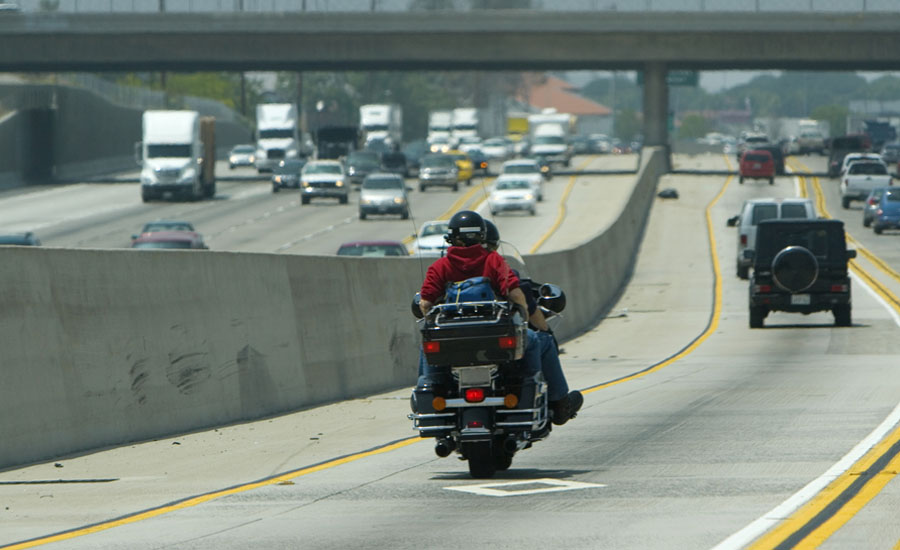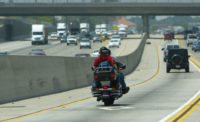NTSB: Warning tech could help prevent motorcycle crashes

Take a closer look at how motorcycle licenses are granted and develop standards for crash warning systems. These are among the recommendations from a National Transportation Safety Board (NTSB) assessment of motorcycle crashes on U.S. roadways, which claimed 5,286 lives in 2016.
Motorcyclists—motorcycle riders and their passengers—have the highest risk of fatal injury among all motor vehicle users. Per mile traveled, motorcyclist fatalities occurred nearly 28 times more frequently than passenger vehicle occupant fatalities in traffic crashes. “Because motorcycles afford riders less protection, the likelihood of injuries and fatalities in a crash is much greater,” notes the NTSB, who recently released an analysis of accident risk factors and proposed preventative measures.
About the safety analysis
The NTSB used data from the Federal Highway Administration (FHWA) in its analysis to study crashes that occurred in Orange County, California, between 2011 and 2015. The NTSB’s research goals were to (1) identify and assess factors that contribute to motorcycle crash risk, (2) compare these factors with previous research findings about motorcycle crash risk, and (3) evaluate the need for motorcycle safety improvements.
Previous NTSB safety recommendations to encourage universal motorcycle helmet use and to establish a per se blood alcohol concentration (BAC) limit of 0.05 grams per deciliter or lower for all drivers were not reiterated in this new report. Nearly 100% of all motorcycle riders and passengers analyzed in the MCCS were wearing helmets, presumably a direct result of the universal helmet law in California. Although the use of a helmet is an important safety issue associated with the protection of motorcycle riders, accident prevention - not injury mitigation was the focus of the report.
NTSB findings:
- Many high-risk traffic situations between motorcycles and other motor vehicles could be prevented if vehicle drivers were better able to detect and anticipate the presence of a motorcycle when entering or crossing a road, making a turn, or changing lanes.
- Motorcycle riders’ collision avoidance performance could be improved by extending the range of hazard detection and providing riders with more information, enhanced awareness, and more time to react to crash risks.
- Vehicle-based crash warning and prevention systems will be most effective at preventing collisions when they can reliably detect all vehicle types, including motorcycles.
- The integration of motorcycles with connected vehicle-to-vehicle and vehicle-to-infrastructure systems has been limited compared to other vehicle types.
- Antilock braking system technology would improve motorcycle safety by enhancing the effectiveness of rider evasive actions through improved braking performance and stability.
- Stability control systems on motorcycles could reduce single-vehicle crashes that involve loss of control and running wide on a curve and off the road, which would reduce the prevalence of motorcyclists killed or injured by impacts with roadside fixed objects.
- More focused research is required to understand the contribution of alcohol and other drug use as a risk factor in motorcycle crashes and whether specific countermeasures could reduce alcohol- and other drug-related motorcycle crashes.
- Motorcycle licensing procedures have not been adequately evaluated for safety and effectiveness, which makes it difficult to determine if current licensing procedures are achieving reductions in motorcycle crashes, injuries, and fatalities or encouraging unlicensed riders to become fully licensed.
NTSB recommendations
To the National Highway Traffic Safety Administration:
- Incorporate motorcycles in the development of performance standards for passenger vehicle crash warning and prevention systems.
- Incorporate motorcycles in the development of performance standards for connected vehicle-to-vehicle systems.
- Work with the Federal Highway Administration to incorporate motorcycles in the development of performance standards for connected vehicle-to-infrastructure systems.
- Require all new motorcycles manufactured for on-road use in the United States be equipped with antilock braking system technology.
- Conduct or sponsor research to evaluate the effectiveness of stability control systems for motorcycles.
- Develop and publish performance standards for stability control systems on motorcycles, and require systems meeting those standards on all new motorcycles manufactured for on-road use in the United States.
- Examine the influence of alcohol and other drug use on motorcycle rider crash risk compared to that of passenger vehicle drivers, and develop guidelines to assist states in implementing evidence-based strategies and countermeasures to more effectively address substance-impaired motorcycle rider crashes.
- Evaluate the effectiveness of state motorcycle licensing procedures for reducing motorcycle crashes, injuries, and fatalities among novice and unlicensed riders; based on the results of that evaluation, update the Guidelines for Motorcycle Operator Licensing or other guidance as appropriate.
To the Federal Highway Administration:
- Work with the National Highway Traffic Safety Administration to incorporate motorcycles in the development of performance standards for connected vehicle-to-infrastructure systems.
To the Motorcycle Industry Council, the American Motorcyclist Association, and the Motorcycle Safety Foundation:
- Inform your members about the findings of this safety report, and promote the safety benefits of advanced motorcycle antilock braking and stability control technologies.
Looking for a reprint of this article?
From high-res PDFs to custom plaques, order your copy today!




